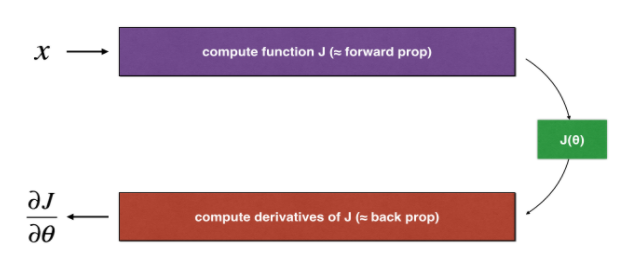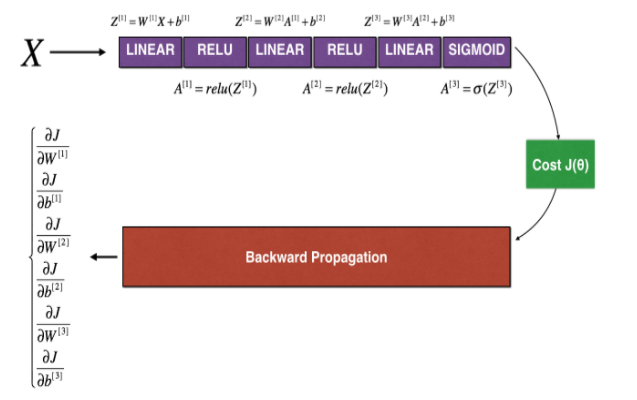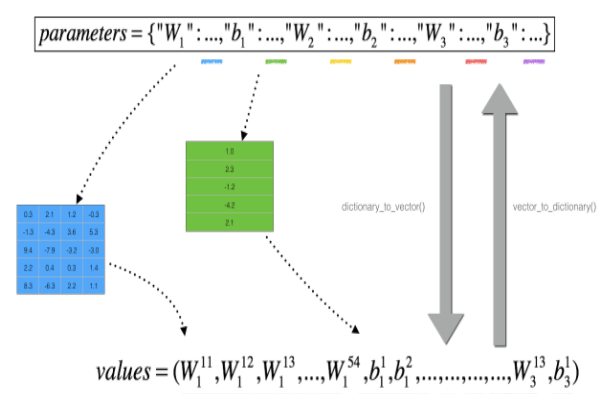深度学习神经网络中的梯度检查

前言
反向传播计算梯度$\frac{\partial J}{\partial \theta}$, $\theta$表示模型的参数。 $J$是使用正向传播和损失函数来计算的。
计算公式如下:
$$
\frac{\partial J}{\partial \theta} = \lim_{\varepsilon \to 0} \frac{J(\theta + \varepsilon) - J(\theta - \varepsilon)}{2 \varepsilon} \tag{1}
$$
因为向前传播相对容易实现,所以比较容易获得正确的结果,确定要计算成本$J$ 正确。因此,可以通过计算$J$ 验证计算$\frac{\partial J}{\partial \theta}$ 。
一维梯度检查
一维线性函数$J(\theta) = \theta x$。该模型只包含一个实值参数$\theta$,并采取x作为输入。

上图显示了关键的计算步骤:首先从开始$x$,然后评估该功能 $J(x)$(“前向传播”)。然后计算导数 $\frac{\partial J}{\partial \theta}$(“反向传播”)。下面就用代码来实现。
导入依赖包
首先我们要导入相应的依赖包,其中一些工具类可以在这里下载。
# coding=utf-8
from testCases import *
from gc_utils import sigmoid, relu, dictionary_to_vector, vector_to_dictionary, gradients_to_vector
正向传播
下面是线性前向传播函数代码:
def forward_propagation(x, theta):
"""
实现线性向前传播(计算J) (J(theta) = theta * x)
Arguments:
x -- 一个实值输入
theta -- 我们的参数,一个实数。
Returns:
J -- 函数J的值, 计算使用公式 J(theta) = theta * x
"""
J = theta * x
return J
反向传播
线性反向传播函数,计算公式是 $dtheta = \frac { \partial J }{ \partial \theta} = x$:
def backward_propagation(x, theta):
"""
计算J对的导数
Arguments:
x -- 一个实值输入
theta -- 我们的参数,一个实数。
Returns:
dtheta -- 成本的梯度。
"""
dtheta = x
return dtheta
开始检查
- 在检查梯度之前首先要求$gradapprox$:
- $\theta^{+} = \theta + \varepsilon$
- $\theta^{-} = \theta - \varepsilon$
- $J^{+} = J(\theta^{+})$
- $J^{-} = J(\theta^{-})$
- $gradapprox = \frac{J^{+} - J^{-}}{2 \varepsilon}$
- 然后使用反向传播计算梯度,并将结果存储在一个变量“grad”中。
- 最后,使用以下公式计算“gradapprox”和“grad”之间的相对差异:
$$
difference = \frac {\mid\mid grad - gradapprox \mid\mid_2}{\mid\mid grad \mid\mid_2 + \mid\mid gradapprox \mid\mid_2} \tag{2}
$$
如果计算得到的结果足够小,就证明是梯度没问题了,以下是梯度检查代码:
def gradient_check(x, theta, epsilon=1e-7):
"""
实现反向传播
Arguments:
x -- 一个实值输入
theta -- 我们的参数,一个实数
epsilon -- 用公式对输入进行微小位移计算近似梯度
Returns:
difference -- 近似梯度与反向传播梯度之间的差异。
"""
# 用公式的左边来计算gradapprox(1)
thetaplus = theta + epsilon # Step 1
thetaminus = theta - epsilon # Step 2
J_plus = thetaplus * x # Step 3
J_minus = thetaminus * x # Step 4
gradapprox = (J_plus - J_minus) / (2 * epsilon) # Step 5
# :检查gradapprox是否足够接近backward_propagation()的输出
grad = backward_propagation(x, theta)
numerator = np.linalg.norm(grad - gradapprox) # Step 1'
denominator = np.linalg.norm(grad) + np.linalg.norm(gradapprox) # Step 2'
difference = numerator / denominator # Step 3'
if difference < 1e-7:
print ("梯度是正确的!")
else:
print ("梯度是错误的!")
return difference
然后执行这一段代码,看看梯度是否正确:
if __name__ == "__main__":
x, theta = 2, 4
difference = gradient_check(x, theta)
print("difference = " + str(difference))
当结果满足difference < 1e-7,梯度是正确的。
梯度是正确的!
difference = 2.91933588329e-10
多维梯度检查
多维梯度模型的向前和向后传播如下图:

LINEAR - > RELU - > LINEAR - > RELU - > LINEAR - > SIGMOID
向前传播
多维梯度的向前传播:
def forward_propagation_n(X, Y, parameters):
"""
实现前面的传播(并计算成本),如图3所示。
Arguments:
X -- m例的训练集。
Y -- m的样本的标签
parameters -- 包含参数的python字典 "W1", "b1", "W2", "b2", "W3", "b3":
W1 -- 权重矩阵的形状(5, 4)
b1 -- 偏差的矢量形状(5, 1)
W2 -- 权重矩阵的形状(3, 5)
b2 -- 偏差的矢量形状(3, 1)
W3 -- 权重矩阵的形状(1, 3)
b3 -- 偏差的矢量形状(1, 1)
Returns:
cost -- 成本函数(一个样本的逻辑成本)
"""
# 检索参数
m = X.shape[1]
W1 = parameters["W1"]
b1 = parameters["b1"]
W2 = parameters["W2"]
b2 = parameters["b2"]
W3 = parameters["W3"]
b3 = parameters["b3"]
# LINEAR -> RELU -> LINEAR -> RELU -> LINEAR -> SIGMOID
Z1 = np.dot(W1, X) + b1
A1 = relu(Z1)
Z2 = np.dot(W2, A1) + b2
A2 = relu(Z2)
Z3 = np.dot(W3, A2) + b3
A3 = sigmoid(Z3)
# Cost
logprobs = np.multiply(-np.log(A3), Y) + np.multiply(-np.log(1 - A3), 1 - Y)
cost = 1. / m * np.sum(logprobs)
cache = (Z1, A1, W1, b1, Z2, A2, W2, b2, Z3, A3, W3, b3)
return cost, cache
反向传播
多维梯度的反向传播:
def backward_propagation_n(X, Y, cache):
"""
实现反向传播。
Arguments:
X -- 输入数据点,形状(输入大小,1)
Y -- true "label"
cache -- 缓存输出forward_propagation_n()
Returns:
gradients -- 一个字典,它包含了每个参数、激活和预激活变量的成本梯度。
"""
m = X.shape[1]
(Z1, A1, W1, b1, Z2, A2, W2, b2, Z3, A3, W3, b3) = cache
dZ3 = A3 - Y
dW3 = 1. / m * np.dot(dZ3, A2.T)
db3 = 1. / m * np.sum(dZ3, axis=1, keepdims=True)
dA2 = np.dot(W3.T, dZ3)
dZ2 = np.multiply(dA2, np.int64(A2 > 0))
dW2 = 1. / m * np.dot(dZ2, A1.T) * 2 # 这有个错误
db2 = 1. / m * np.sum(dZ2, axis=1, keepdims=True)
dA1 = np.dot(W2.T, dZ2)
dZ1 = np.multiply(dA1, np.int64(A1 > 0))
dW1 = 1. / m * np.dot(dZ1, X.T)
db1 = 4. / m * np.sum(dZ1, axis=1, keepdims=True) # 这有个错误
gradients = {"dZ3": dZ3, "dW3": dW3, "db3": db3,
"dA2": dA2, "dZ2": dZ2, "dW2": dW2, "db2": db2,
"dA1": dA1, "dZ1": dZ1, "dW1": dW1, "db1": db1}
return gradients
开始检查
同样这个还是用回来之前的公式:
$$
\frac{\partial J}{\partial \theta} = \lim_{\varepsilon \to 0} \frac{J(\theta + \varepsilon) - J(\theta - \varepsilon)}{2 \varepsilon} \tag{3}
$$
但有一些不同的是,$\theta$ 不再是一个标量。这是一个叫做“参数”的字典。
其中函数是“ vector_to_dictionary”,它输出“参数”字典,操如下图:

For each i in num_parameters:
- 计算
J_plus[i]:- Set $\theta^{+}$ to
np.copy(parameters_values) - Set $\theta^{+}_i$ to $\theta^{+}_i + \varepsilon$
- 使用
forward_propagation_n(x, y, vector_to_dictionary($\theta^{+}$))计算$J^{+}_i$
- Set $\theta^{+}$ to
- 计算
J_minus[i]:同样计算$\theta^{-}$ - 计算$gradapprox[i] = \frac{J^{+}_i - J^{-}_i}{2 \varepsilon}$
最后使用以下的公式计算结果差异:
$$
difference = \frac {| grad - gradapprox |_2}{| grad |_2 + | gradapprox |_2 } \tag{4}
$$
def gradient_check_n(parameters, gradients, X, Y, epsilon=1e-7):
"""
检查backward_propagation_n是否正确地计算了正向传播的成本输出的梯度。
Arguments:
parameters --包含参数的python字典 "W1", "b1", "W2", "b2", "W3", "b3":
grad -- backward_propagation_n的输出包含参数的成本梯度。
x -- 输入数据点,形状(输入大小,1)
y -- true "label"
epsilon -- 用公式对输入进行微小位移计算近似梯度
Returns:
difference -- 近似梯度与反向传播梯度之间的差异。
"""
# Set-up variables
parameters_values, _ = dictionary_to_vector(parameters)
grad = gradients_to_vector(gradients)
num_parameters = parameters_values.shape[0]
J_plus = np.zeros((num_parameters, 1))
J_minus = np.zeros((num_parameters, 1))
gradapprox = np.zeros((num_parameters, 1))
# Compute gradapprox
for i in range(num_parameters):
thetaplus = np.copy(parameters_values) # Step 1
thetaplus[i][0] = thetaplus[i][0] + epsilon # Step 2
J_plus[i], _ = forward_propagation_n(X, Y, vector_to_dictionary(thetaplus)) # Step 3
thetaminus = np.copy(parameters_values) # Step 1
thetaminus[i][0] = thetaminus[i][0] - epsilon # Step 2
J_minus[i], _ = forward_propagation_n(X, Y, vector_to_dictionary(thetaminus)) # Step 3
# Compute gradapprox[i]
gradapprox[i] = (J_plus[i] - J_minus[i]) / (2 * epsilon)
# 通过计算与反向传播梯度比较差异。
numerator = np.linalg.norm(grad - gradapprox) # Step 1'
denominator = np.linalg.norm(grad) + np.linalg.norm(gradapprox) # Step 2'
difference = numerator / denominator # Step 3'
if difference > 2e-7:
print (
"\033[93m" + "反向传播有一个错误! difference = " + str(difference) + "\033[0m")
else:
print (
"\033[92m" + "你的反向传播效果非常好! difference = " + str(difference) + "\033[0m")
return difference
最后运行一下这个多维梯度检测:
if __name__ == "__main__":
X, Y, parameters = gradient_check_n_test_case()
cost, cache = forward_propagation_n(X, Y, parameters)
gradients = backward_propagation_n(X, Y, cache)
difference = gradient_check_n(parameters, gradients, X, Y)
以下是输出结果,可以看到已经超过最低的误差了:
反向传播有一个错误! difference = 0.285093156781
所以我们知道backward_propagation_n的代码有错误!这时我们可以去检查backward_propagation并尝试查找/更正错误,最后我们找到以下的代码出了错误:
dW2 = 1. / m * np.dot(dZ2, A1.T) * 2
db1 = 4. / m * np.sum(dZ1, axis=1, keepdims=True)
然后我们修改正确的代码:
dW2 = 1. / m * np.dot(dZ2, A1.T)
db1 = 1. / m * np.sum(dZ1, axis=1, keepdims=True)
我们再检查一遍的结果是:
你的反向传播效果非常好! difference = 1.18904178766e-07
参考资料
该笔记是学习吴恩达老师的课程写的。初学者入门,如有理解有误的,欢迎批评指正!